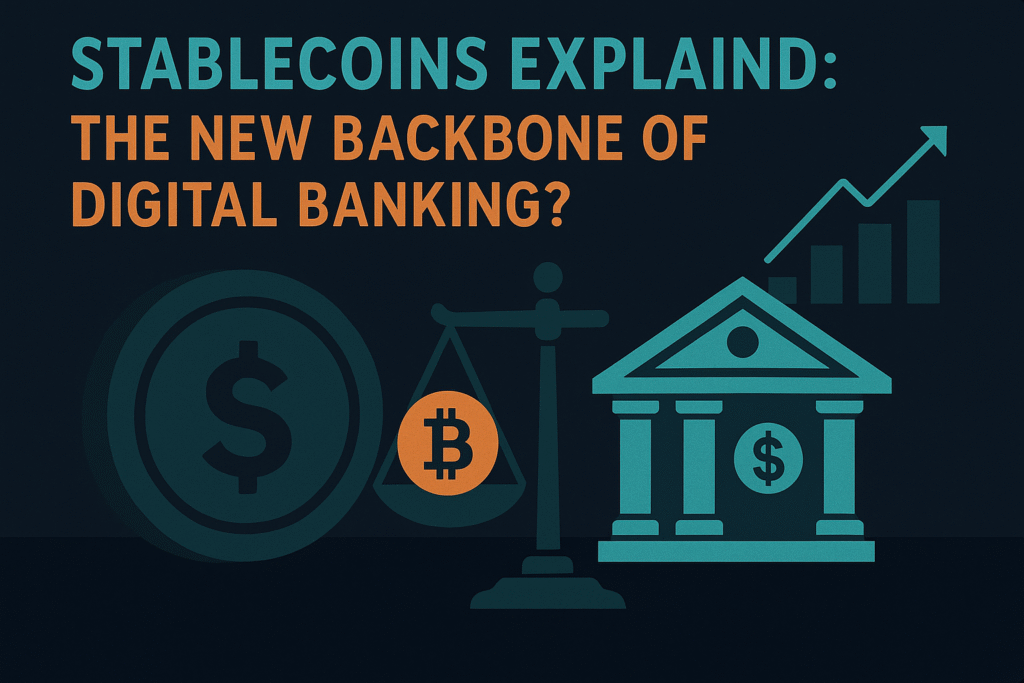In the ever-evolving world of digital finance, one type of cryptocurrency has quietly become indispensable — stablecoins.
While Bitcoin captures headlines and Ethereum fuels innovation, stablecoins are the silent infrastructure making the crypto economy practical, liquid, and usable for billions.
In 2025, they’ve become more than just a “bridge” between fiat and crypto.
They’re shaping the future of banking, payments, and global finance.
But what exactly are stablecoins, and how are they transforming money itself?
The Rise of Stability in a Volatile Market
Cryptocurrency was designed to disrupt traditional finance — but its biggest flaw has always been volatility.
You can’t pay salaries, invoices, or international suppliers in an asset that might lose 20% of its value overnight.
Enter stablecoins — digital tokens designed to maintain a fixed value, usually pegged to fiat currencies like the U.S. dollar (USD) or euro (EUR).
They combine the transparency and speed of blockchain with the price stability of traditional money.
The most popular examples include:
- USDT (Tether) – the oldest and most traded stablecoin, widely used on exchanges.
- USDC (USD Coin) – backed by U.S.-regulated institutions, trusted by fintech companies and banks.
- DAI (MakerDAO) – a decentralized, crypto-backed stablecoin that operates autonomously through smart contracts.
Each represents a new form of programmable money — currency that moves globally in seconds, without intermediaries.
The Infrastructure of the New Digital Economy
Behind the scenes, stablecoins have quietly become the financial plumbing of the blockchain economy.
They serve as the settlement layer for decentralized finance (DeFi), cross-border trade, and even emerging digital banks.
In 2025, over $150 billion worth of stablecoins circulate globally, processing more transaction volume than Visa in some months.
What makes them so powerful isn’t just their price stability — it’s their versatility.
They’re used to:
- Transfer value instantly between exchanges and wallets.
- Pay for goods and services without the friction of traditional banking.
- Serve as on-chain collateral for loans, staking, and yield farming.
- Provide liquidity for DeFi protocols and tokenized markets.
Think of them as the digital dollars of the blockchain age — moving freely, 24/7, across borders, with full transparency and programmable logic.
Stablecoins vs. Banks: A Quiet Revolution
Stablecoins are challenging traditional banking in ways few expected.
In many developing regions, they already function as a more accessible alternative to local currencies and unstable economies.
While banks close on weekends and charge high international transfer fees, stablecoins enable people to send millions in seconds for a fraction of a cent.
Companies like Circle (USDC) and PayPal (PYUSD) are even integrating stablecoins into digital banking platforms, allowing users to hold, send, and convert crypto within mainstream financial apps.
This fusion of crypto and fintech is paving the way for a hybrid system — one where blockchain rails move the money, but regulated institutions ensure trust and compliance.
In short: stablecoins are becoming the new backbone of digital banking, bridging the gap between traditional finance (TradFi) and decentralized finance (DeFi).

Regulation and the Path Toward Legitimacy
The biggest evolution of stablecoins isn’t just technological — it’s legal.
In 2025, global regulators have finally started to recognize and standardize stablecoins as legitimate financial instruments.
The U.S. Stablecoin Trust Act requires issuers to hold full, auditable reserves and submit regular transparency reports.
In the European Union, MiCA regulations define stablecoins as “asset-referenced tokens” and set strict rules for issuance and circulation.
This regulatory clarity is a game-changer.
It allows institutional investors, banks, and governments to safely adopt blockchain infrastructure without the fear of unregulated risk.
Stablecoins are moving from the shadows of crypto into the spotlight of finance — becoming tools for efficiency, inclusion, and accountability.
The Future: Tokenized Money and Global Liquidity
The long-term potential of stablecoins goes beyond trading or speculation.
They are the foundation for tokenized economies, where everything — from real estate to carbon credits — can be represented digitally and settled instantly.
Imagine a world where:
- A company in Germany pays its supplier in Argentina in seconds, using tokenized euros.
- A farmer in Africa receives stablecoin loans via smartphone, bypassing banks entirely.
- Central banks issue their own CBDCs (Central Bank Digital Currencies), interoperable with stablecoins for seamless trade.
This vision isn’t science fiction — it’s already happening.
Stablecoins are becoming the universal language of money — borderless, programmable, and transparent.
A Word of Caution
Despite their potential, stablecoins aren’t without risk.
Some issuers have faced controversy over opaque reserves, and algorithmic stablecoins (like the failed TerraUSD) proved how dangerous overengineering can be.
The lesson is clear: trust and transparency are everything.
The future of stablecoins depends on strong auditing, clear regulations, and integration with responsible financial systems.
Final Thoughts
Stablecoins are not just another crypto trend — they are the missing bridge between digital innovation and financial stability.
They make blockchain usable, reliable, and scalable for everyday people and institutions alike.
As we move deeper into the digital age, the money we use will no longer be tied to banks, borders, or even paper.
It will live on-chain — secure, transparent, and instantaneous — powered by the quiet strength of stablecoins.
And whether you realize it or not, the next time you send money online, you might already be using one.
¿Quieres que te cree ahora la portada sin texto, con una ilustración elegante y tecnológica, mostrando monedas digitales estables (USDC, USDT, DAI) flotando sobre una infraestructura bancaria digital o blockchain azul, en tonos azul, blanco y dorado, transmitiendo estabilidad, confianza y modernidad financiera?
